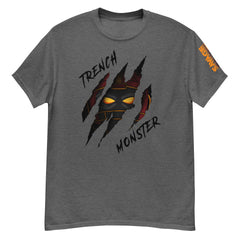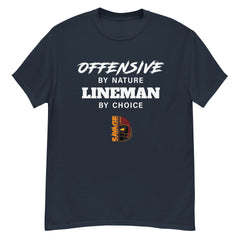Editor’s Note: Every year, new players and new parents get an introduction to competitive football. I was recently asked to explain to some “newbies” more about the offensive and defensive lines since the casual fan often hasn’t paid any attention to those positions. So this post springs from that discussion in hopes that it will help more newcomers to the great game understand the often overlooked Trenches!
Football is more than just the art of the touchdown. At the heart of every play is a battle that usually goes unseen by the casual viewer. It is commanded by the linemen - offensive and defensive. Despite their essential roles, these players are rarely the focus of the limelight. This article seeks to shed light on these unsung heroes, diving deep into their responsibilities, techniques, and invaluable contributions to the game.
The Offensive Line: Protectors of the Kingdom
The offensive line is like the secret service of football: vigilant, protective, and often sacrificing themselves for the greater good.
Pass Protection
When it comes to passing plays, the linemen form the vanguard. They ensure that the quarterback has enough time and space to identify his target and release the ball. This is not a mere push-and-shove affair. It demands a deep understanding of defensive strategies, quick identification of blitzes, and on-the-fly adjustments. Each lineman must be in sync with his teammates, aware that even a momentary lapse can lead to disastrous consequences for the quarterback.
Run Blocking
Running plays present a different challenge. Here, linemen morph from protectors to aggressors. They initiate contact, aiming to create space for the running back. This involves intricate techniques like pulling, where a lineman moves laterally across the line before engaging a defender, and trap blocks that lure a defender in, only to be blocked by another lineman from the side.
Mental Agility
Contrary to popular belief, being an offensive lineman isn't just about physical strength. It's a mental game too. Linemen must interpret defensive alignments, anticipate blitzes, and constantly communicate with one another, making their role as mentally taxing as it is physically demanding.
The Defensive Line: Disruptors of Rhythm
While the offensive line stands as a shield, the defensive line plays the role of the battering ram, constantly seeking to breach enemy lines.
Edge Rush
Defensive ends are the sprinters of the line. Positioned on the outermost edges, they often combine speed with strategy, aiming to outmaneuver or overpower their blockers to reach the quarterback or stop running backs on outside runs. Techniques like the "swim" or "rip" move are often employed to defeat blockers.
Interior Dominance
The defensive tackles are the anchors. Positioned inside, their bulk and strength become the team's first line of defense against running plays. They engage in a tug of war with offensive linemen, using techniques like the "bull rush" to drive blockers backward or the "spin" move to twist around them.
Versatility
A hallmark of a top-tier defensive lineman is adaptability. The ability to switch positions, to transition from an interior role to an edge role, or vice versa, adds an element of unpredictability, making it challenging for offenses to strategize.
Linemen's Impact on Game Dynamics
While the skill players often get the spotlight for their game-changing plays, it's essential to understand how linemen directly influence many of football's strategic layers. Their contributions might not always result in highlight-reel footage, but they're indispensable in crafting the ebb and flow of a match.
Setting the Tone
The physicality and tenacity of the linemen can set an emotional precedent for the entire team. When an offensive line successfully overpowers its opponents, driving them back play after play, it sends a clear message of dominance. This can be a significant morale booster, elevating the confidence of every player on the team.
Similarly, a defensive line that consistently penetrates the offensive front, causing disruptions, and making emphatic tackles, can energize the entire defense. These actions can demoralize the opposing offense, causing them to second-guess their strategies and play with hesitation.
Field Position
Consistent blocking success by the offensive line translates to sustained drives. Every successful rush or protected pass can move the chains further down the field. This progression doesn't just aim for touchdowns; even if a drive stalls, it can result in a favorable punt position, pinning the opposition deep in their territory.
The defensive line plays a significant role here as well. By generating pressure that leads to sacks, they push the opposing offense backward. A significant tackle for loss or sack can drastically alter the opponent's play-calling, potentially forcing a punt from a disadvantaged field position.
Clock Management
The offensive line's ability to control the line of scrimmage has a profound impact on the game's tempo. By effectively blocking for run plays, they allow the offense to steadily advance, chewing up the clock in the process. Prolonged drives not only provide scoring opportunities but also keep the opponent's offense on the sideline, thus wearing down the opposing defense and limiting the adversary's scoring chances.
Conversely, a dominant defensive line can force quick three-and-out situations, ensuring their team gets the ball back faster and reduces the opposing team's time of possession. By frequently disrupting plays and causing negative yardage, they can quickly turn the tide of a game.
Injury Prevention
Every snap in football carries a risk of injury, especially for high-profile players like quarterbacks. An offensive line that excels in protection reduces this risk significantly. By effectively stopping aggressive pass rushers and ensuring that running backs aren't frequently hit in the backfield, they not only improve the team's performance but also ensure the longevity of star players.
The game of football, in all its complexity, is a collection of coordinated moves, strategies, and moments. While the skill players might deliver the highlights, it's the linemen who provide the foundations of the game. Their influence can be monumental. Recognizing and appreciating their contributions is crucial for any true aficionado of the sport.
Savage Style has the right stuff for the new folks and the old timers


